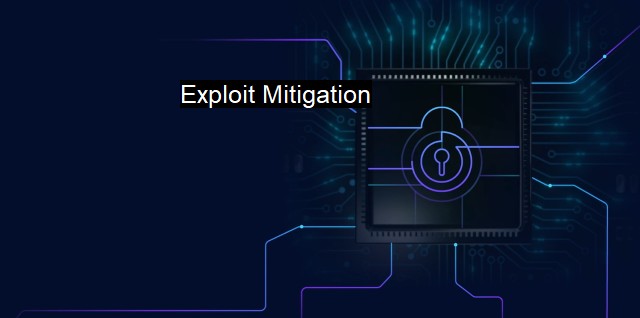What is Exploit Mitigation?
Exploring Exploit Mitigation: Guarding Against Cyber-Attacks and Cyber Threats Using Advanced Techniques to Stifle Malicious Tactics and Hardware Vulnerabilities to Secure Data and Systems from Harm.
Exploit mitigation is a crucial component of cybersecurity strategies, aimed at protecting computer systems, networks, and data from potential vulnerabilities that can be exploited by malicious entities. Implemented primarily through specialized antivirus and security software, exploit mitigation essentially aims to deter, resist and minimize the damages from cyber threats like malware, ransomware, phishing, etc."Exploit" in cybersecurity parlance refers to a piece of software or coded command created and used by cybercriminals to manipulate a flaw, vulnerability or bug, in software or applications. Exploitable vulnerabilities are potential access points into a network or system, strengthening undesirable attacks, data theft, unauthorized system control and other cybercrime related activities.
Exploit mitigation, therefore, is a process through which systems are safeguarded from such exploits. This is usually achieved through various methods such as data execution prevention, address layout randomization, structured exception handling overwrites protection and similar other methods which we will dive into the specifics of as we go along.
Data execution prevention (DEP) adds a crucial layer to exploit mitigation measures by designating certain parts of a system's memory non-executable. It is aimed at preventing an exploit from running code from a non-executable memory region. DEP helps in mitigating a class of exploits called Buffer Overflow, where a hackers might overflow the buffer with a malicious code with the hope that the system's memory executes it.
Another common technique used to mitigate exploits is Address Space Layout Randomization (ASLR). ASLR works by constantly shuffling and randomizing the address layout of a device's or system's memory space to make it difficult for the malicious software to predict where the code will be next. This factor of unpredictability makes it strenuous for the exploit to locate the specific vulnerability point, hence reducing the possibilities of an effective cyberattack.
Structured Exception Handling Overwrite Protection (SEHOP) is yet another component of comprehensive exploit mitigation arsenal, particularly for Windows operating systems. SEHOP enhances protection against malicious handle overwrites, and is an instrumental mitigation tool against the execution of code through Structured Exception Handlers (SEHs) in Windows-based applications.
Other protectors such as Control Flow Guard (CFG) examine the reliability of crucial pointers to functions during compile-time and run-time, mitigating exploits that attempt to tamper flow execution. Similarly, Antivirus, Antimalware and firewall software incorporate ingenious scanning and heuristic techniques to detect and neutralize potential exploits in real-time.
Embracing the concept of 'Defense in Depth', exploit mitigation makes use of multiple layers of security controls. System hardening, multifactor authentication, network segregation, web filter applications, secure coding concepts, routine vulnerability assessment and pen testing form integral components of this strategy. where threats rapidly evolve necessitating the simultaneous evolution of defense parameters, exploit mitigation practices condense and concentrate their attempts and resources towards reducing and eliminating exploitable areas to harden cyber resilience.
Exploit mitigation techniques should not be viewed as standalone measures. They are components of a more comprehensive cybersecurity program and practices. For instance, they should be combined with other measures, like keeping software up to date and regular patching, which could help in reducing vulnerabilities that a system may have.
Exploit mitigation deploys strategic, tactical and deferential measures to eliminate potential exploits, i.e., the computer weaknesses that could be manipulated to launch cyberattacks. As cybersecurity challenges transform, morph and evolve, exploit mitigation techniques, powered by antivirus and related cyber technology, must simultaneously transform and evolve too, to provide a comprehensive and effectual die-hard safeguarding.

Exploit Mitigation FAQs
What is exploit mitigation?
Exploit mitigation refers to a set of techniques and strategies used in cybersecurity to prevent or minimize the damage caused by an exploit. These techniques include identifying and patching vulnerabilities, controlling access to sensitive data and system resources, and detecting and blocking malicious activity.Why is exploit mitigation important?
Exploit mitigation is important because it can help prevent cyberattacks and protect organizations from security breaches. By implementing effective exploit mitigation strategies, organizations can reduce the risk of damage to their systems, data, and reputation.What are some common techniques used for exploit mitigation?
Some common techniques used for exploit mitigation include implementing access controls and authentication mechanisms, using firewalls and intrusion detection systems, regularly patching software and operating systems, utilizing anti-malware and antivirus software, and conducting regular vulnerability assessments and penetration testing.Can exploit mitigation guarantee complete protection against cyberattacks?
No, exploit mitigation cannot guarantee complete protection against cyberattacks. While effective exploit mitigation can greatly reduce the risk of a successful attack, cybercriminals are constantly developing new and more sophisticated attack methods. It is important for organizations to stay up-to-date with the latest cybersecurity trends and regularly reassess their security strategies to stay protected against new and emerging threats.| | A | | | B | | | C | | | D | | | E | | | F | | | G | | | H | | | I | | | J | | | K | | | L | | | M | |
| | N | | | O | | | P | | | Q | | | R | | | S | | | T | | | U | | | V | | | W | | | X | | | Y | | | Z | |
| | 1 | | | 2 | | | 3 | | | 4 | | | 7 | | | 8 | | |||||||